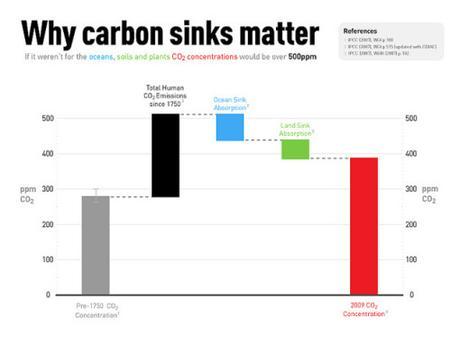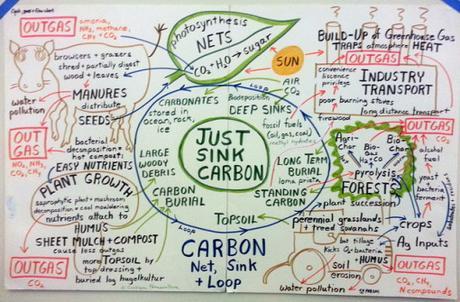Carbon sinks are very important for our environment, because they act like sponges to soak up the carbon compounds that are playing such an enormous role in global climate change. Basically, carbon sinks are holding tanks for carbon or carbon compounds, like carbon dioxide (CO2).
One of the largest reservoirs of carbon is the Earth’s hard rock crust. Over the eons sedimentary rocks were formed that contain loads of carbon compounds, including the hydrocarbons that we now use as fossil fuels. Sedimentary rocks may hold an enormous amount of carbon, but they are not considered a carbon sink because they no longer take in more carbon than is released primarily through volcanic eruptions. In fact, due to man’s use of fossil fuel, they are a source of much of the excess CO2 in our atmosphere.
Wikipedia says,
A carbon sink is a natural or artificial reservoir that accumulates and stores some carbon-containing chemical compound for an indefinite period. The process by which carbon sinks remove carbon dioxide (CO2) from the atmosphere is known as carbon sequestration.
That said, the fact that ages and ages ago the formation of sedimentary rocks took in more carbon than was released is a good illustration of how carbon is always changing forms. Much of the Earth’s carbon is in flux – moving from sources to sinks and then transforming back into sources again. This cycle is called the global carbon cycle within which carbon sinks play a primary role.
Read here more about carbon footprint , carbon sequestration and carbon credits.

The main sources of carbon include combustion of fossil fuels (coal, oil and gas) for sake of energy and transportation by humans, fires (also includes wildfires) and farmland.
Carbon sinks can be natural or man-made. They absorb more carbon than they release whereas carbon source is anything that releases more carbon than they absorb. Forests, soil, ocean and the atmosphere all store carbon and this carbon moves between them in a continuous cycle. Plants take up CO2 from the atmosphere that and use it in the process of photosynthesis. When plants die, some of this carbon is transferred to soil as they decompose. Oceans are major carbon storage systems. Together Earth’s land and Ocean sinks absorb half of the carbon dioxide emissions. Carbon sequestration is a process that is used to remove carbon the atmosphere to mitigate the effects of global warming.
Natural Carbon Sinks
There are three main natural carbon sinks:
- Plants
- Soil
- Oceans
Plants
Green plants play a huge role in controlling CO2 levels, because of the process they use to live: Photosynthesis. The process of photosynthesis occurs in the cells of microscopic organisms and within the leaves of a plant. It uses solar radiation energy, or sunlight, to change carbon dioxide and water into a glucose like carbon sugar.
Once the sugar is processed, it is further converted and used in a variety of other molecules, such as fats and proteins and starch and enzymes. Once this is complete, the process of photosynthesis then releases oxygen that is needed for plants and animals.
It is generally accepted that approximately half of all carbon that is extracted from the atmosphere is done through the process of photosynthesis.
Soil
Carbon is the main component of the organic matter that makes fertile agricultural soil. It also helps soil retain water. Plants are the primary way that CO2 is transferred to soil. Not all of the CO2 that plants suck up for photosynthesis is needed for food. The excess goes down through their roots and feeds organisms that live in the soil. Carbon from the roots and leaves of dying plants is also captured in soil.
Oceans
The world’s oceans are its workhorse for absorbing and storing carbon. Photosynthesis plays a role along with other biological processes that work together to sequester CO2 and other carbon compounds.
- Biological Pump
This process moves CO2 from the surface down into the depths of the ocean where it is stored, or sequestered, for eons. How does the carbon get from the atmosphere into the water? The first step is photosynthesis used by microscopic aquatic organisms called phytoplankton.
Phytoplankton float on the surface of oceans and use photosynthesis to produce the energy they need to live. So, just like green plants, they suck up CO2 from the atmosphere. Phytoplankton are a key part of the ocean’s food chain, but if they aren’t eaten they die and start the second stage of the biological pump when they start sinking through the ocean.
The dead organisms cluster together as they sink, increasing their mass and reducing the risk of being consumed. The final stage of the pump is when these clusters of dead phytoplankton reach the ocean floor where they, and the CO2 they contain, remain for thousands of years.
- Diffusion
Sometimes called the Solubility Pump, diffusion is a process that allows the atmosphere and the water to exchange carbon dioxide molecules. Basically, when the CO2 pressure in the air is higher than the surface water, the atmospheric CO2 diffuses, or dissolves, into the ocean.
The amount of CO2 absorbed through diffusion depends on the water’s temperature and currents. A cold ocean is able to absorb more CO2 than a warmer ocean.
- Calcium Carbonate
Calcium Carbonate is the primary ingredient that Clams, oysters, coral and other hard bodied aquatic creatures depend on to create their hard shells. This carbon compound is produced by carbon dioxide combining with calcium that has previously been dissolved in seawater. When these organisms die, their body parts and shells sink deep into the ocean to the seafloor thus hiding, or burying, carbon.
Over a long period of time these dead organisms create carbonate rich deposit layers at the floor of the ocean. After millions of years have passed, more and more carbonates form, which then creates heat and pressure that causes them to turn into sedimentary rocks. This includes chalk, marble and limestone.
Examples of Natural Carbon Sinks
Now that you know the three basics, here a just a few of the many natural carbon sinks found throughout the globe.
- Grasslands
- Agricultural lands
- Northern, boreal forests
- Tropical Rainforests
- Peat Bogs
- Freshwater lakes and wetlands
- Coastal ecosystems such as seagrass beds, kelp forests, salt marshes and swamps
- Coral reefs
Artificial Carbon Sinks
Manmade carbon sinks can be created or use existing underground formations, or even the oceans, to store CO2. The main artificial sinks are landfills and carbon capture and storage processes. Artificial carbon sequestration is a good example of man-made carbon sinks. Maybe you’ve heard of clean coal? Well, the idea behind clean coal is capturing the CO2 that coal-fired power plants produce and basically burying it, or sequestering it, forever.
Much research is going on in this area including:
- Capturing and CO2 and storing it by injection into the ocean floor or underground empty rock formations that used to hold fossil fuels, like depleted oil reservoirs.
- Replicating the natural process of mineral carbonation that uses CO2 to transform natural minerals into carbonate rocks like limestone.
- Stimulating the growth of microorganisms in the southern oceans by fertilizing the surface with iron.
- Manufacturing “artificial trees” complete with leaves treated with chemical compounds (like sodium carbonate) that soak up CO2 from the atmosphere.

Protecting and Restoring Carbon Sinks
Man continues to interfere with carbon sinks, but sometimes in a positive way. Efforts are underway to protect and rejuvenate natural sinks that we have degraded over time. These include:
- Reforestation
- Creating new forests (afforestation)
- Improved Soil conservation
- Prairie restoration
- Forest conservation
- Open space protection including grasslands and meadows
- Seagrass habitat restoration
- Wetlands protection and restoration
- Coral reef conservation and restoration
Soaking it all up
Carbon is an essential element of life and the carbon cycle is a critical process for our Earth. Carbon sinks play a primary role in the global carbon cycle and are vital to the world and every living, breathing being that is in it. They control the amount of carbon concentration that is found in our environment and keep our lives healthy and the air that we breathe worthy of breathing in.
What can you do to help? Plant a garden, or grow a tree. By some estimates, one single tree can lock away a ton of CO2 by its 40th birthday. Also, planting trees around your home or office building provides shade in the summer that can reduce the use of air conditioners powered by fossil fuels.
There are many ways to get involved, the important thing is to get engaged and understand how important the ocean and our land really is, and do your part to help further reduce emissions. Vow to change and do more to protect those carbon sinks that the world needs. This is our world, and we must all come together in order to solve a problem. We need these carbon sinks greatly and we need to do everything within our power to protect them.

